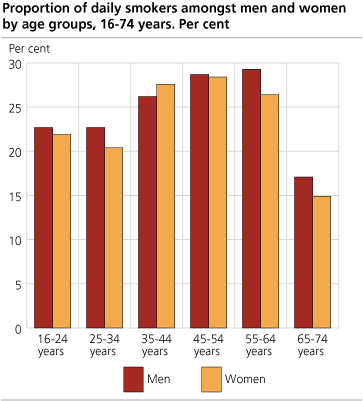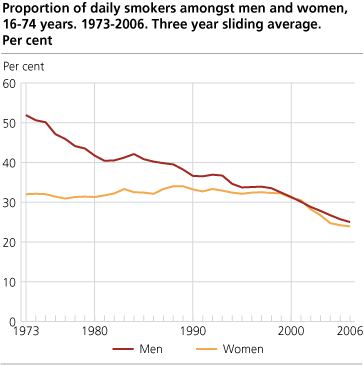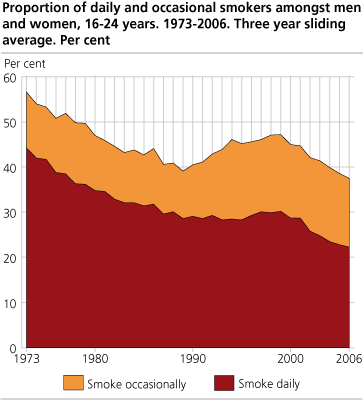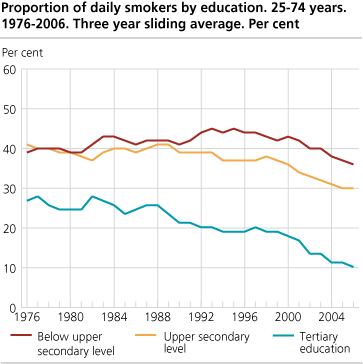Content
Published:
This is an archived release.
The share of daily smokers is still decreasing
In 2006, 24 per cent of people aged 16-74 smoked daily, a decrease of one percentage point compared with 2005. Since 1998, the share has continuously been reduced, and the total number of young people smoking is going clearly down.
Statistics Norway conducts surveys on the use of tobacco every year. The 2006 surveys show that 24 per cent of the population in the age of 16-74 report that they smoke on a daily basis, compared to 25 per cent in 2005. In addition, approximately 10 per cent smoked occasionally in 2006, compared to 11 per cent in 2005.
There are no differences between men and women - the proportion of daily smokers is 24 per cent in both groups. The corresponding figures in 2005 were 26 per cent for men and 24 per cent for women.
The largest proportion of daily smokers is found amongst people aged 35-64, and the smallest share is reported by the youngest and the oldest in the population.
A decrease from 1998
In 1973, more than half of the adult male population was smokers, while the proportion today is 24 per cent. From 1973 to 2000, the proportion of female daily smokers was slightly above 30 per cent, but also the share of female smokers has been considerably reduced and is now 24 per cent. There seems to have been a shift in the trend around 1998. From then on, we see a similar reduction in the proportion of smokers amongst both men and women.
Fewer smokers amongst young people aged 16-24
In 2006, about 20 per cent of young people in the age of 16-24 reported that they smoke on a daily basis. In addition, 14 per cent smoke occasionally. This is a decrease from respectively 24 and 17 per cent in 2005, thought the differences are not significant (with a 95 per cent confidence interval). However, since the sample is relatively small, it is best suited to view long-term trends rather than yearly changes.
The number of young people who start smoking has considerably decreased compared with the 1970s. The major decline observed until the end of the 1980s, was not found for quite some years, at the same time as the proportion of occasional smokers increased markedly from the beginning to the middle of the 1990s. Now, however, it seems that the trend is again developing in a positive direction, and the total number of young people smoking is clearly going down.
Educational background is an important factor
Education has a substantial effect on the smoking pattern. More than three times the proportion of those with education below secondary level smoke compared to those with tertiary education. The number of daily smokers amongst those with tertiary education has declined considerably since the mid 1970s, while the proportion amongst those below secondary level has not decreased much. When this is seen in relation to the total share of smokers, the change in the level of education in the population as a whole must be taken into consideration (See http://www.ssb.no/english/subjects/04/01/ ).
| Proportion daily smokers, by age. 1997-2006. Observed result and estimated three-year sliding average |
| year | Daily smokers 16-74 years | Daily smokers 16-24 years | |||||||||||||||||||||||||||||||||||||
|---|---|---|---|---|---|---|---|---|---|---|---|---|---|---|---|---|---|---|---|---|---|---|---|---|---|---|---|---|---|---|---|---|---|---|---|---|---|---|---|
| Observed result | Estimated three year sliding average | Sample size (N) | Observed result | Estimated three year sliding average | Sample size (N) | ||||||||||||||||||||||||||||||||||
| 1997 | 33.6 | 33.2 | 5 305 | 30.6 | 30.1 | 819 | |||||||||||||||||||||||||||||||||
| 1998 | 33.0 | 32.9 | 5 088 | 31.2 | 29.9 | 797 | |||||||||||||||||||||||||||||||||
| 1999 | 32.0 | 32.3 | 4 913 | 27.7 | 30.2 | 783 | |||||||||||||||||||||||||||||||||
| 2000 | 31.9 | 31.2 | 5 004 | 31.5 | 28.7 | 806 | |||||||||||||||||||||||||||||||||
| 2001 | 29.8 | 30.3 | 5 047 | 26.8 | 28.7 | 781 | |||||||||||||||||||||||||||||||||
| 2002 | 29.4 | 28.5 | 5 311 | 27.8 | 25.8 | 819 | |||||||||||||||||||||||||||||||||
| 2003 | 26.3 | 27.3 | 5 094 | 22.8 | 24.8 | 812 | |||||||||||||||||||||||||||||||||
| 2004 | 26.0 | 25.8 | 5 034 | 23.7 | 23.5 | 852 | |||||||||||||||||||||||||||||||||
| 2005 | 25.0 | 25.0 | 5 029 | 24.1 | 22.8 | 833 | |||||||||||||||||||||||||||||||||
| 2006 | 23.9 | 124.5 | 4 756 | 20.3 | 122.3 | 763 | |||||||||||||||||||||||||||||||||
| 1 | Average of 2005 and 2006. |
|
About the survey
Statistics Norway has conducted surveys on the use of tobacco for more than thirty years. The proportion of smokers is measured by two questions: "Do you sometimes smoke?" and "Do you smoke daily or occasionally?" In the course of a year, four surveys with a total net sample of 5 000 people are carried out. There are possible sources of error in any interview survey. Therefore, error margins of more than one percentage point both ways are used in the surveys. To counteract the effect of random changes in the data, a three-year sliding average is used. This is particularly important in those periods where the sample has been smaller than it is today. A three-year sliding average means that the average of the results for three consecutive years is calculated, and that this average represents the second year. |
The statistics are produced every year on behalf of the Directorate for Health and Social Affairs.
Contact
-
Elin Skretting Lunde
E-mail: elin.skretting.lunde@ssb.no
tel.: (+47) 92 42 70 07
-
Jorun Ramm
E-mail: jorun.ramm@ssb.no
tel.: (+47) 92 08 23 99
-
Arne Jensen
E-mail: arne.jensen@ssb.no
tel.: (+47) 99 71 22 45




